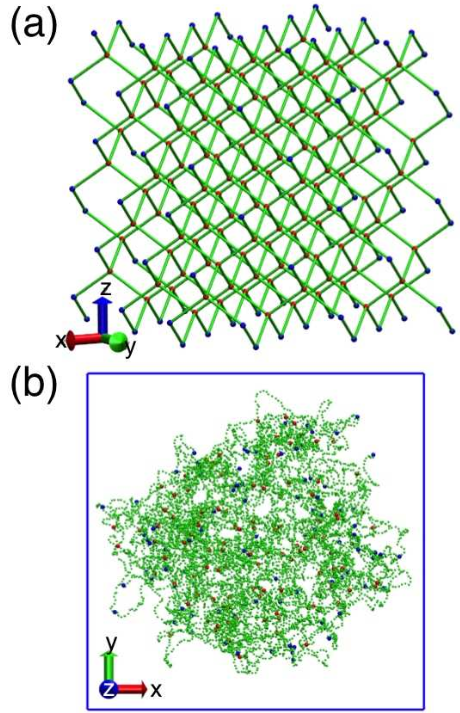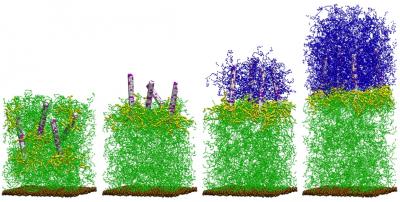A material that can regenerate itself when damaged
November 29, 2013
What if you could program a broken or damaged object to regenerate itself — replenishing the damaged or missing components, and extending its lifetime — instead of replacing it or requiring costly repairs? Now University of Pittsburgh researchers have developed computational models of a new polymer gel that could do just that.
“This is one of the holy grails of materials science,” noted Anna C. Balazs, PhD, the Swanson School’s Distinguished Robert v. d. Luft Professor of chemical and petroleum engineering and an author of a Nano Letters paper. “Others have developed materials that can mend small defects, [but ] there is no published research regarding systems that can regenerate bulk sections of a severed material. This has a tremendous impact on sustainability because you could potentially extend the lifetime of a material by giving it the ability to regrow when damaged.”
The research team was inspired by biological processes in species such as amphibians, which can regenerate severed limbs.
A biomimetic dynamic cascade

a) Initial configuration of a functional gel network. (b) Top-down view of the equilibrium state of a swollen gel in a solvent at a temperature of 293.15 K. The green beads represent the polymer strands, the red beads are cross-linkers, and the blue beads are dangling ends with a lower connectivity. (Credit: Xin Yong et al./Nano Letters)
“When we looked at the biological processes behind tissue regeneration in amphibians, we considered how we would replicate that dynamic cascade within a synthetic material,” Balazs said.
“We needed to develop a system that first would sense the removal of material and initiate regrowth, then propagate that growth until the material reached the desired size and then, self-terminate the process.”
“Our biggest challenge was to address the transport issue within a synthetic material,” Dr. Balazs said. “Biological organisms have circulatory systems to achieve mass transport of materials like blood cells, nutrients and genetic material.
Synthetic materials don’t inherently possess such a system, so we needed something that acted like a sensor to initiate and control the process.”
Hybrid material: nanorods + gel
The team developed a hybrid material of nanorods about ten nanometers in thickness embedded in a polymer gel, which is surrounded by a solution containing monomers (a molecule that can combine with others to form a polymer) and cross-linkers (molecules that link one polymer chain to another) to replicate the dynamic cascade.
When part of the gel is severed, the nanorods near the cut act as sensors and migrate to the new interface. The functionalized chains or “skirts” on one end of these nanorods keeps them localized at the interface, and the sites (or “initiators”) along the rod’s surface trigger a polymerization reaction with the monomer and cross-linkers in the outer solution.
The idea is to control the process so that the new gel behaves and appears like the gel it replaced, and to terminate the reaction so that the material would not grow out of control, guided by three critical instruction sets — initiation, propagation, and termination — which Balazs described as a “beautiful dynamic cascade” of biological events.
Sequoia redwood-tree model
In the future, the researchers plan to improve the process and strengthen the bonds between the old and newly formed gels, and for this they were inspired by another nature metaphor, the giant sequoia tree.
“One sequoia tree will have a shallow root system, but when they grow in numbers, the root systems intertwine to provide support and contribute to their tremendous growth,” Balazs explained. Similarly, the skirts on the nanorods can provide additional strength to the regenerated material.
The next generation of research would further optimize the process to grow multiple layers, creating more complex materials with multiple functions.
Other principal investigators and co-authors are Xin Yong, PhD, postdoctoral associate, who is the article’s lead author; Olga Kuksenok, PhD, research associate professor; and Krzysztof Matyjaszewski, PhD, J.C. Warner University Professor of Natural Sciences, department of chemistry at Carnegie Mellon University.
Abstract of Nano Letters paper
With newly developed computational approaches, we design a nanocomposite that enables self-regeneration of the gel matrix when a significant portion of the material is severed. The cut instigates the dynamic cascade of cooperative events leading to the regrowth. Specifically, functionalized nanorods localize at the new interface and initiate atom transfer radical polymerization with monomers and cross-linkers in the outer solution. The reaction propagates to form a new cross-linked gel, which can be tuned to resemble the uncut material.
